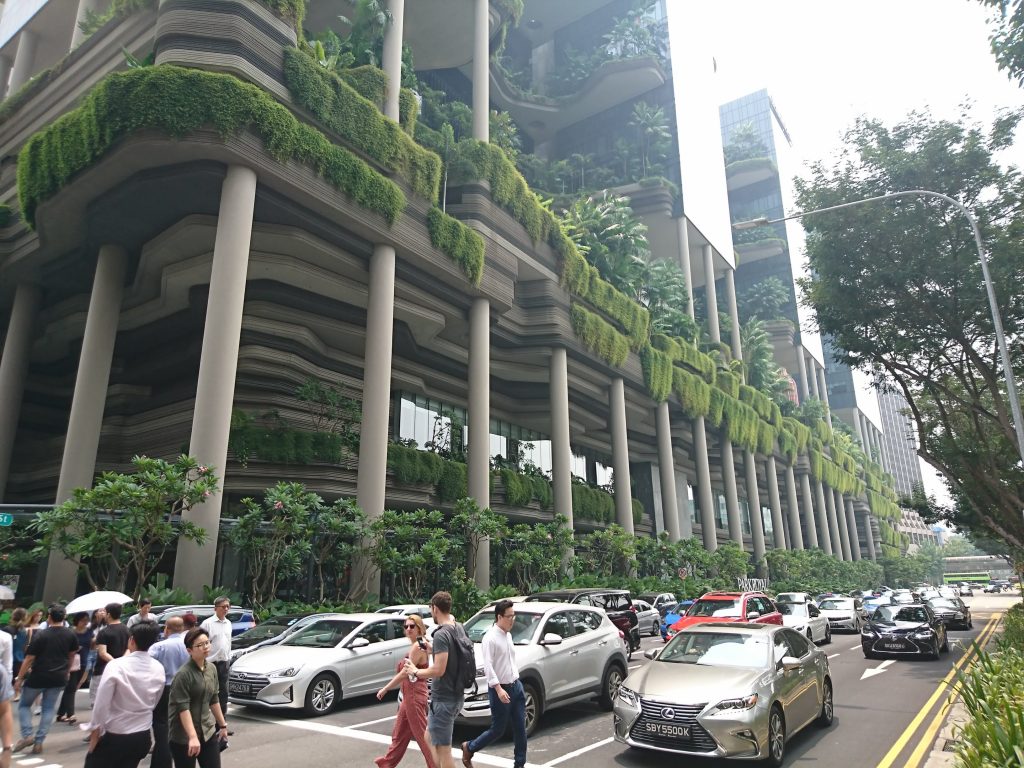Singapore has been known as a city in a garden ever since the government coined the vision and term “garden city” in the 1967. It has pursued policies to expand new green infrastructure and replace any that is lost due to urban development – taking advantage of its tropical environmental; and they have been successful.
In 2020 46.5% of Singapore’s land was covered in green space, with a tree canopy percentage of almost 30%, one of the greenest cities in the world; with over 300 km of green corridors as part of the city state’s ‘Park Connector Network’.
In addition to the focus on urban green space, public transport has become an emphasis for the city state due to the countries small geographical size – so private motor vehicles could not be the dominate mode of transport.

This has led to a focus on enhancing public transport, cycling and walking as means of transport, which Singapore have linked with their urban green space (UGS) development and protection policies and practice. Of which a now fundamental feature is the Park Connector Network, started in 1991 and created as part of the city’s Greening and recreational strategy.

Key Urban green space and walking policies and practice
- Green infrastructure as a priority for urban development. The LUSH – Landscaping for Urban Spaces and High-Rises Programme outlines the use of Green walls and buildings policies for all new buildings – which can make up 10% of landscape replacement on developments. In strategic areas, developments are subject to creating landscaping areas that are 100% of the development site area; and all developments must replace any greenery building removes. Whilst housing developments are also required to have access to green space

- Creating Green Mobility Corridors through the Park Connector Network: The PCN saw increases in visits to parks and increases in walking and cycling rates., and use for exercising, commuting and social activities on the network. Showing that linking sustainable transport and urban green infrastructure together can create huge linear green spaces that improve urban walkability.

- Singapore’s blue walking networks: The early stages of the PCNs development focused around combing walking routes along the countries canals, waterfront and blue spaces.

- Shaded and covered walkways & pedestrian crossings: 200km of sheltered walkways were created between 2018-20. Ensuring protection from sun and rain as part of Singapore’s tropical climate for pedestrians from housing, commercial and transport hubs

- Walk Cycle Ride SG – is the countries vision for inclusive city transport – and under which they are looking to improve walking routes and environments
- Engaging with the public has been important: since Singapore’s inception as a country engaging with it’s citizens to create a greener Singapore has been essential. Some examples of current methods of engagement include the protection of trees and a focus on interpretation and information to the public such as with the Civic District Tree Trail.
Best Practice Examples – Singapore combining urban green space and walking infrastructure

- Park Connector Network and green walking corridors: 7 large PCN Loops make up the over 300 km of PCNs that cover the majority of the island state; and there are plans for developing it further.
- Green buildings: Singapore is the leading developer of green buildings and their policies ensure that any development creates accessible green space that is then incorporated into walking networks.
- Shaded and covered walkways: covered and shaded walking routes ensure that walking is more comfortable and in turn will encourage people to walk more.
What can cities learn from Singapore

- Fundamentally if they are going to be able to continue to create more urban green space, cities must enshrine the protection of existing and expansion of new urban green infrastructure in it’s city wide development strategy and policies.
- Linking UGS policies with planning and building development to ensure a net gain of green space as part of any development is key. Whilst also linking these policies with transportation and mobility policies that promote walking.
- Whilst housing, commercial developments and other major trip generators must be linked with green space provision; and importantly linked with green space via green walking corridors that provide attractive, comfortable and safe walking environments.
- The PCN model can be used by other cities to create their own context specific green and blue walking networks – taking advantage of what existing networks there currently are and then filling in the gaps and extending them.
- Ensure the local context and culture is incorporated into the city’s green walking network; addressing weather, climate and existing population behaviours and culture.
What next

- Singapore’s continued expansion of green corridors & pedestrian focused greening such as continued expansion and legacy planting of street trees and roadside planting.
- Walking infrastructure and its network can be improved in Singapore by increasing pedestrian space and priority on the street networks, which of course must also include green infrastructure; and be linked with future reductions in space and priority for private motor vehicles to increase Singapore’s walkability.
In summary: Singapore has protected green space in its development strategies and practice since its inception as a country. This has resulted in one if the highest rates of green space globally. In addition, the combining of walking infrastructure with green infrastructure both leads to more comfortable walking environments but also wide spread access to urban green space. The island state’s current policies that prioritise walking and greenery must remain in place to ensure this trajectory continues into the future.
Published: October 2020

